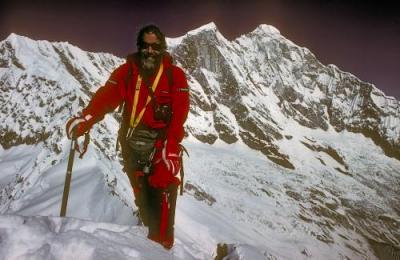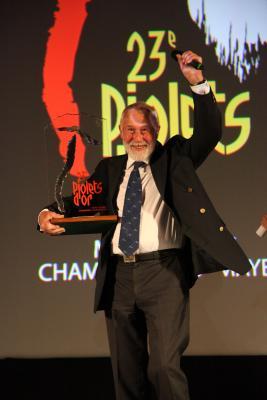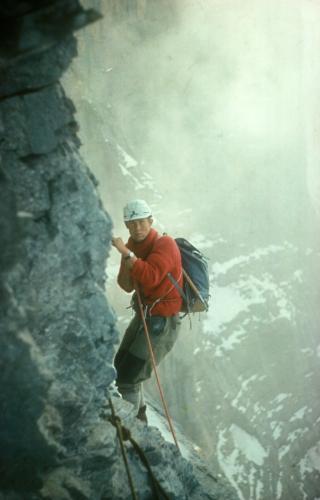Insider Interview: Sir Chris Bonington

COURMAYEUR - The 7th Piolet d'Or career award was awarded to Chris Bonington Saturday, at the closing ceremony of an event that has been dubbed “the Oscars of alpinism”.
The Piolet d'Or is in its 23rd year and honours the best climbs from around the world undertaken in alpine style. Since 2009 the Career Piolet d'Or has been given to distinguished Alpinists whose careers have inspired future generations to discover the mountains.
By winning the career Pilet d'Or Bonnington joins a small but prestigious club of mountaineers, following in the footsteps of iconic figures such as Walter Bonatti, who won the award in 2009, and Reinhold Messner who picked up the gong in 2010.
Bonington has enjoyed a glittering career, completing many notable first ascents as well as putting up new routes on a huge number of mountains. In 1970 he led the first successful expedition up the south face of Annapurna and in 1975 led the first expedition up the south-west face of Everest.
Last year, after the loss of his wife Bonington re-climbed the Old Man of Hoy aged 80 - he had been part of the original team to first climb the sea stack in 1966. He was knighted in 1966 and lives in the Lake District where he balances climbing with working in his garden.
Italian Insider caught up with Sir Chris at the event to talk about his award, his career and the future of Alpinism...
What does winning the Piolet d'Or mean to you?
It means a huge amount, it's such a special award for any climber because it's the recognition of your own community.
You've had a phenomenally successful career both as a mountaineer and explorer. What's the most memorable moment if you can choose just one?
There have been so many memorable moments I suppose, but actually the greatest, fun climbs I've ever had weren't the big giants. It was probably when Jim Fotheringham and I climbed the west peak of Shivling. It was a fast attempt, five days up Alpine style. It was quite serious because we knew we couldn't get back down the way we had come and we knew nothing about the other side of the mountain. We got down okay but it was quite hairy.
For me, that climb had all the elements of adventure. It was spontaneous as we had changed our objective and nobody knew we were doing it. Had anything happened to us I doubt anyone would ever have found us. So it was very committing but it just worked out. Two is the ideal number, I'm not a solo climber and I like company, but with four or six it takes a bit longer to make decisions.
You've led some major expeditions in your time – what skills differentiate a great climber from a great leader?
I think to lead an expedition, particularly a siege style expedition which was the traditional old style expedition were there was quite a few people you've got to be able to manage personalities. You've got to be a good planner and organizer and you've got to be a very good delegator and give the right jobs to the right people.
You've got to almost feel the pulse of the expedition the whole time and respond to it. It's a very lonely job as well because you can't afford to show uncertainty – but for a hell of a lot of the time you are uncertain.
On some of your expeditions there has been a loss of life. As expedition leader does that weigh on you? Are there moments when you think “what if...?”
No there's no point in that – hindsight’s a waste of time. I grieve for every single person who's been lost but we all knew what we were going into as extreme climbing at altitude is very difficult and dangerous so you've got to accept it, however hard it is.
Last year you climbed the Old Man of Hoy at 80 – How much climbing and training do you still do?
Before the Old Man of Hoy none at all because my wife had been grievously ill so I was very upset and couldn't climb. I wanted to climb it and it was almost a kind of catharsis. On the climb I pulled a disk very, very quickly but I climbed through the pain and did a lot of damage but climbing it would've been a struggle anyway!
If you had the body of a 35 year old what climbs would you most like to undertake?
You know, I don't think I could ever have done the super-athletic climbs that the modern generation are doing. You've got to train for that and I've never trained, my training has just been going climbing.
Last Year an Ice fall on Everest killed 16 Sherpas – and the Sherpa Community went on Strike for the remainder of the season. What's your view on the treatment of Sherpas?
The Sherpas are well paid by Nepalese standards and accidents like that are absolutely inevitable. From time to time a big avalanche comes down and anyone in its way gets killed. It's a tragedy but it's part of the job and I think one's got to observe it as that.
There have been calls to stop climbing on Everest or make it harder for people to obtain permits – how do you react to that?
I think there is an argument for that in the sense that the mountain is desperately overcrowded. On the other hand, if you do start rationing it out there are so many people who dream of climbing Everest and in some ways I believe in a free market. If you really want to go and climb Everest go and do it!
Here in the Alps too, Mont Blanc is attempted by 20,000 climbers a year – some people would call for permits to be issued....
I think the fewer permits you have in the mountains the better. If you want to avoid the crowds on the Mont Blanc massif just don't go for the popular routes. There are so many brilliant routes in the back and beyond. You probably won't get famous for doing them, and you probably can't say at a dinner party “Oh I've climbed the southwest face of the Aiguille du Tacul”. I climbed it in 1957 and I'm not sure if anyone's bothered with it since.
You're old Climbing partner Don Whillans was famously from a working class background – is modern climbing accessible enough to people from working class backgrounds?
I should say it is considerably more accessible! Back in the late 40's early 50's there were many less working class climbers, hours were longer the money was less and so on. I think today there's many more opportunities. I hope the differentiation between working class, upper class blue collar white collar and everything else vanishes! You're either a climber or you're not and a plumber is every bit as good as a scientist.
Some traditional Alpine guides would say that traditional ways of life are being threatened by skiing and adventure tourism – would you go along with that?
It's about getting a balance. I mean those communities have improved their standard of living considerably and you've got to regard it as an almost inevitable development. Now areas of Khumbu are being modernized with electricity, nightclubs, internet cafès and everything else. That's just the way things develop and there's not much point in regretting it. You can't keep everything as it was forever.




